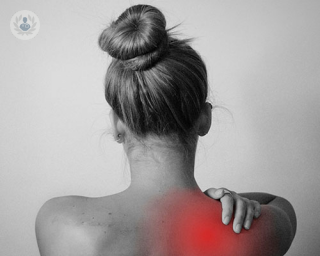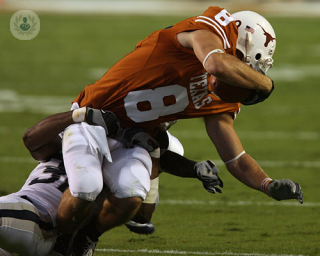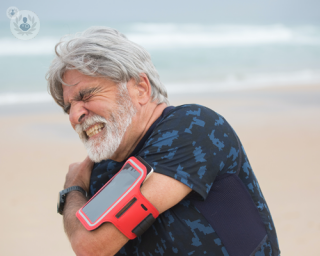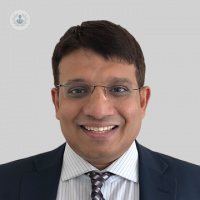Shoulder pain
Dr Martynas Juozaitis - Pain medicine
Created on: 09-12-2022
Updated on: 01-18-2024
Edited by: Carlota Pano
What is shoulder pain?
Shoulder pain is any kind of pain that occurs in or around the shoulder joint, including the shoulder blades.
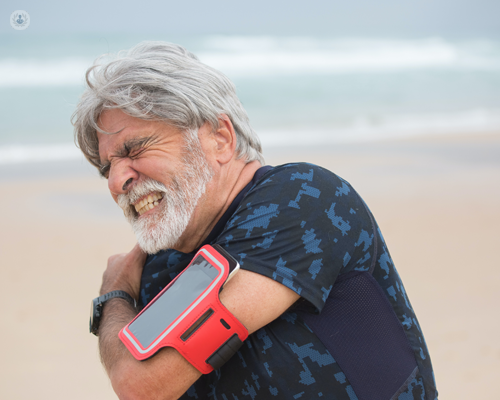
What are the different types of shoulder pain?
You can experience very specific types of shoulder pain, such as:
- aching shoulder pain
- shooting shoulder pain
- sharp shoulder pain
- warm or burning shoulder pain
What conditions cause these types of shoulder pain?
Aching shoulder pain
- Shoulder arthritis
The symptoms of shoulder arthritis can include deep pain and stiffness that commonly manifests at the back of the shoulder. The time of day and level of activity may affect when symptoms are more prevalent.
- Frozen shoulder
Frozen shoulder causes aching shoulder pain that gets noticeably worse over time. Another symptom of frozen shoulder is sharp, or shooting, pain, especially when the condition starts. People with frozen shoulder also experience gradual loss of passive range of motion where a joint has a limited amount of movement.
- Rotator cuff tears
Aching pain and weakness that gets worse with activity is one of the main symptoms of this shoulder condition. A rotator tear can also lead to difficulty in lifting your arm overhead.
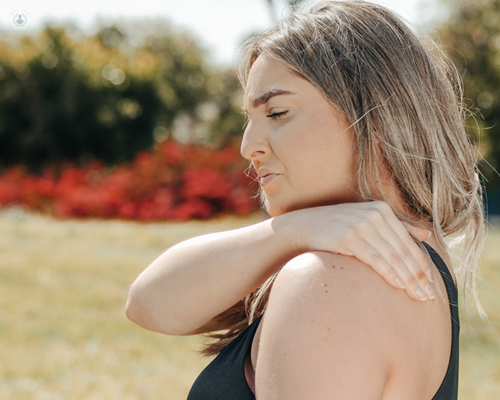
- SLAP (Superior Labrum Anterior Posterior) tear
This type of shoulder tear can cause aching pain at either the back or front. Certain movements can trigger extra pain, as well as popping, clicking, grinding or locking sensations.
- Rotator cuff tendonitis or tendinopathy
The aching pain that's characteristic of rotator cuff tendonitis can be felt at the top of the shoulder or outside of the upper arm. The pain can be made worse by repetitive movements.
Shooting shoulder pain
- Pinched nerve
Weakness or a pins-and-needles sensation in the hand or arm characterises pinched nerves, but they can also cause pain that travels from the neck or shoulder into the arm or hand.
- Brachial plexus injuries
The pain that defines brachial plexus injuries can also come with numbness, pins and needles and weakness. These shoulder injuries are caused by trauma and affect the network of nerves that travel through the neck, shoulder, arm and hand. Some of these types of injuries are called 'stingers'.
Sharp shoulder pain
- AC joint arthritis
Acromioclavicular joint osteoarthritis may cause sharp pain at the front and top of the shoulder. This is where the collarbone meets the shoulder blade. The pain may be triggered by certain movements such as doing a bench press, reaching across the body or raising the arm overhead.
- Shoulder impingement syndrome
When the arm is raised, this shoulder pain is sharp or pinching on the outside of your shoulder.
Warm or burning shoulder pain
- Infection
The shoulder joint can be infected, and it can cause it to feel painful and hot. Swelling, redness and/or fever can indicate that there is infection.
- Shoulder bursitis
This type of shoulder condition is caused by an inflamed and irritated bursa, and may cause burning pain. Bursa that inflamed may swell up and add to shoulder impingement syndrome.
- Rheumatoid arthritis
Rheumatoid arthritis can affect larger joints like the shoulder, as well as typically small joints in the hands and feet. It's characterised with joint warmth, inflammation, swelling and pain.
What are common shoulder injuries in athletes?
The most common shoulder injuries in athletes which are all associated with shoulder pain are:
- shoulder dislocations
- rotator cuff tendonitis and rotator cuff tears
- labral and SLAP tears
Shoulder dislocations
The shoulder joint is the most vulnerable to dislocation and traumatic dislocations. They can be very painful, even when the shoulder has been put back into place. It may be necessary to wear a sling around your arm and shoulder, put ice on your shoulder on a regular basis and see a physiotherapist. The chance of dislocation happening again is greatly increased once a shoulder has been dislocated.

Rotator cuff tendonitis and rotator cuff tears
Also known as subacromial impingement, bursitis, impingement syndrome and supraspinatus tendonitis, some other common injuries for athletes are rotator cuff tears and rotator cuff tendonitis.
Injuries to the rotator cuff, frequently caused by repeated heavy lifting or overhead throwing, can result in severe pain and weakness. These movements can cause inflammation of the rotator cuff and also cause pain that radiates from the front of the shoulder to the side of the arm.
Labral and SLAP tears
Labral tears frequently develop after a fall or direct blow to the shoulder. However, they also can develop as a result of throwing or pulling injuries. Superior labral anteroposterior (SLAP) tears happen in athletes that do sports such as baseball, rugby and weights. Arthroscopic surgery may be required to treat labral or SLAP tears.
How can you tell whether shoulder pain is serious?
You should seek immediate medical attention for shoulder pain if:
- You experience fever or feel unwell
- There's no feeling in your arm or shoulder
- You are experiencing severe pain in both shoulders
- Your arm or shoulder is hot or cold to touch
- You have sudden shoulder pain
- You have pins and needles, or paresthesia
- You've had an injury or accident, such as a fall, and the pain started after that
- Your arm or shoulder is badly swollen or has changed shape
- You can't move your arm
How can shoulder pain be prevented?
Exercises and stretches are the best ways to prevent injuries and shoulder pain before they even happen. They increase strength and flexibility.
However, these techniques are also useful if you want to prevent shoulder reinjury, alongside utilising rehabilitation techniques such as physiotherapy, rest, and the use of ice.
Exercises you can do for shoulder problems include: arm swings, both forward, back and side to side, and arm circles alongside shoulder flexes, side rotation with weight and wall slides.
What is the treatment for shoulder pain?
Mild shoulder pain can be addressed by modifying your activities, taking over-the-counter medicine, and mild stretches. However, if you require further attention there are more treatment options for shoulder pain depending on the condition or injury.
Physiotherapy is an effective treatment for shoulder pain that is a result of these conditions:
- frozen shoulder
- rheumatoid arthritis
- osteoarthritis
- joint hypermobility syndrome
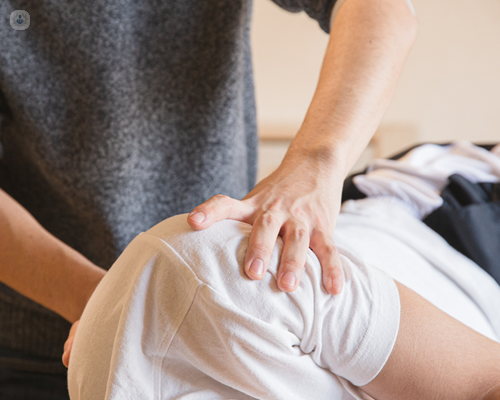
- Dislocated shoulder
Once initial treatment for dislocated shoulder has taken place, you may need to return to a physiotherapist for follow up care to rehabilitate and strengthen your shoulder.
- Shoulder impingement
Physiotherapy is the initial treatment for shoulder impingement. However, steroid injections into your shoulder can help to relieve pain if rest and exercise on its own doesn't help.
A last resort for shoulder impingement is arthroscopic surgery. This involves widening the space around the rotator cuff tendon, which means that it won't run or catch on anything close to it.
- Bursitis
If bursitis is caused by an infection, antibiotics are usually taken for a week. An inflamed bursa may need to be surgically drained or, on rare occasion, removed.
- Tendonitis and shoulder impingement
Tendonitis and shoulder impingement can be treated using steroid injections and/or surgery.
- Dislocated shoulder
If ligaments, tendons and other tissues are torn when a shoulder is dislocated, keyhole surgery may be required.
Another option is bone manipulation (reduction). Your arm will be gently manipulated back into it's shoulder joint. Sometimes this procedure is done under general anaesthetic.
Further treatment options include shockwave therapy and platelet-rich plasma (PRP) injections.
When your shoulder hurts without an injury, what does it mean?
Shoulder pain that's dull, achy, sharp or severe without injury may be caused by:
- osteoarthritis
- rheumatoid arthritis
- shoulder impingement
- frozen shoulder
- thoracic outlet syndrome
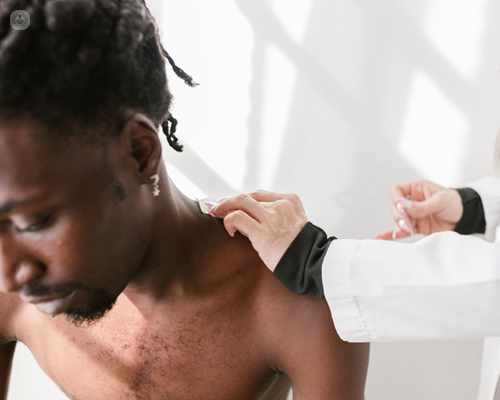
Various non-orthopaedic related conditions can also lead to shoulder pain, including:
Additionally:
- myocardial ischaemia
- ruptured ovarian cyst
- Paget's disease
- pericarditis
- thoracic outlet syndrome (TOS)
Which specialist treats shoulder pain?
Specialist doctors that treat shoulder pain are orthopaedic surgeons, pain medicine specialists, and physiotherapists, who help in the ongoing treatment, including recovery from shoulder pain and injuries.

